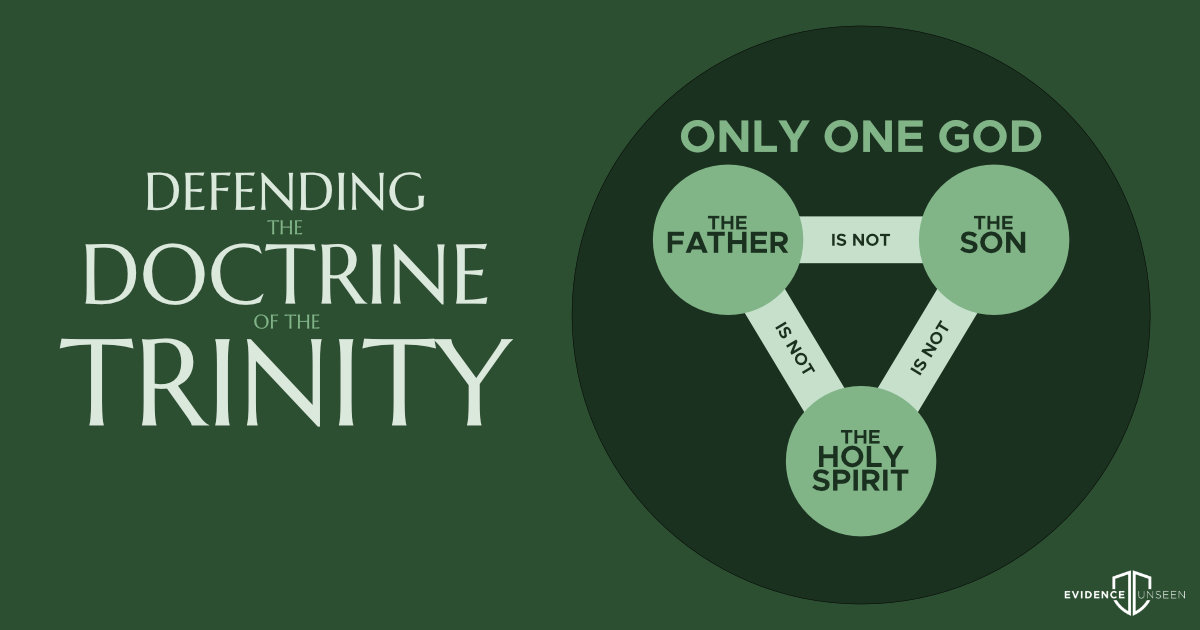 How can the vast majority of evangelical Christians affirm the doctrine of the Trinity (92%), but also affirm that Jesus was a created being (61%) and the Holy Spirit is an impersonal force (55%)?[1] Suffice to say, many Christians are deeply confused about this essential Christian teaching.
How can the vast majority of evangelical Christians affirm the doctrine of the Trinity (92%), but also affirm that Jesus was a created being (61%) and the Holy Spirit is an impersonal force (55%)?[1] Suffice to say, many Christians are deeply confused about this essential Christian teaching.
What about you? Can you accurately define and defend the Trinity? How would you respond to these common objections?
- If Jesus is God, then why does Jesus refer to God as “the only true God”? How many gods are there?
- How can you believe in such a confusing doctrine when “God is not a God of confusion”?
- If each person in the Trinity is God, then it’s simple math: 1 + 1 + 1 =3. Apparently, Christians can’t add.
- Where does the word Trinity appear in the Bible? Did you know that this doctrine wasn’t fully developed until the Council of Chalcedon in AD 451?
- If the Trinity is true, then God kept it hidden from the Jewish people for thousands of years because it isn’t in the Old Testament.
Our goal is not only to define and defend the Trinity, but to show how this biblical teaching reveals the very heart of God’s love.
Articles on the Trinity
Defining the Trinity Definitions are key. As one person said, “A problem well-defined is half-solved.” Theologians define the Trinity in these ways.
What is a Good Illustration for the Trinity? No perfect illustration exists for the doctrine of the Trinity. However, many useful illustrations exist. We disagree with theologians who are so focused on precision that they are hypercritical of any and all illustrations. Indeed, what’s the alternative? Will we simply have nothing to say if someone is struggling to grasp this complex concept?
A Biblical Defense of the Trinity The concept of the Trinity is the most accurate description of what Scripture teaches regarding God’s nature. It explains the most amount of the data (i.e. explanatory scope), and it explains it convincingly (i.e. explanatory power). To make a case for the Trinity, we will defend three central propositions:
- There is only ONE GOD
- The Father, Son, and Holy Spirit are all DISTINCT PERSONS
- The Father, Son, and Holy Spirit are all TRULY GOD
If these three propositions are true, what are we left with? The Trinity! There is one God, who exists in three distinct persons.
A Philosophical and Evidential Defense of the Trinity Critics of Christianity raise many philosophical or evidential objections against the doctrine of the Trinity. If the critic could show that the Trinity is logically incoherent (like a square-circle or married bachelor), then this would discredit this doctrine. But can the critic demonstrate this? Each objection should be considered carefully.
Biblical Objections to the Trinity Critics of Christianity also raise many biblical objections against the doctrine of the Trinity. If the critic could show that the Bible doesn’t teach the Trinity, then this would discredit this doctrine. But can the critic demonstrate this? Each objection should be considered carefully.
Why is the Trinity Essential and Meaningful? The Trinity is not merely some dry doctrinal affirmation studied by scholars. It is truly at the heart of the Christian faith. It gives us intellectual, existential, sociological, and devotional insights that change our lives.
Theological Further Reading
Michael Reeves, Delighting in the Trinity (Downers Grove, IL: InterVarsity Press, 2012).
This is the best devotional book on the Trinity in print. His central thesis is that the Trinity gives us a rational basis for believing that God is loving, outward, and compassionate. Reeves shares insights from some of the greatest minds in church history to advance his points, so it feeds the mind as well as the heart. Highly recommended!
James White, The Forgotten Trinity (Minneapolis, MN: Bethany House, 1998).
By his own admission, White’s book is more for the believer, than the non-believer. In chapters 1 through 3, he outlines the definition of the Trinity, and he explains that the Bible is inherently monotheistic. Then, in chapters 4 through 9, he offers an exegetical case for the deity of Christ. Chapter 10 gives a case for the deity and personality of the Holy Spirit. Chapters 11 and 12 offer a further explanation of the Trinity, defining it with clear definitions. Chapter 13 covers the early church fathers, and it cites their view of the Trinity. Chapter 14 is really a concluding chapter that emphasizes the practical importance of the Trinity. White’s book is well-done, and he keeps most of the technical material in the footnotes, so the newer student of Scripture won’t be bogged down. He also keeps the length of the book to 224 pages.
Robert Bowman, Why You Should Believe in the Trinity: An Answer to Jehovah’s Witnesses (Grand Rapids, MI: Baker Book House), 1989.
Bowman is an apologist with advanced degrees in theology. He specializes in working with cult groups. In this book, he gives a detailed defense of the Trinity from the early church fathers (chapter 3) and the Bible (chapters 4-10).
Ron Rhodes, Reasoning from the Scriptures with the Jehovah’s Witnesses (Eugene, OR: Harvest House Publishers, 2009).
Wayne Grudem, Systematic Theology (Grand Rapids, MI: Zondervan, 1994).
Millard J. Erickson, Christian Theology., 2nd ed. (Grand Rapids, MI: Baker Book House, 1998), “Part Three: What is God Like?”
We prefer Erickson’s Christian Theology to just about any other on the market. He is fair and balanced in his assessment of contrary views. However, we felt that his chapter on the Trinity wasn’t as strong as Grudem’s, who handled the subject better. Grudem’s three-pronged argument for the doctrine was helpful in thinking through the issue, and was very influential on the structure of this article.
Millard J. Erickson, Making Sense of the Trinity (Grand Rapids, MI: Baker Academic, 2000).
Louis Berkhof, Systematic Theology (Grand Rapids, MI: Wm. B. Eerdmans publishing co., 1938).
Robert A. Morey, The Trinity: Evidence and Issues (Iowa Falls, IA: World Pub., 1996), 87-164.
Chapters 7-9 offer evidence for God being multi-personal in the OT. He appeals to OT theophanies and gives an elaborate exposition of the passages that describe the “angel of the LORD.” These chapters are quite good. However, Morey fails to make conservative claims in his writing. He repeatedly states that it is “impossible” to deny his conclusions, there is “no way to escape” his interpretation, there is “no other interpretation” that explains the text, or his interpretation is the “only one” that does justice to the text. In large measure, we agreed with Morey’s conclusions, but these sorts of exaggerations and overstatements should be avoided. It’s better to simply say, “This explanation is the best interpretation of the text.”
Robert Letham, The Holy Trinity (Phillipsburg, NJ: P&R Publishing, 2004).
Letham’s book is an exhaustive treatment of the Trinity. He gives a good treatment of the biblical data (chs.1-3), but he spends extensive time charting the historical development of the Trinity—even into modern times (chs.4-17). Historical theology is the major focus of the book.
Philosophical Further Reading
Norman L. Geisler, Systematic Theology (Arlington, TX: Bastion Books, 2021).
Geisler received formal training in philosophy at the doctoral level. This gives valuable insight into the attributes of God. At the same time, Geisler had a very strong command of the Scriptures and devotion to the Scriptures. This makes his systematic theology valuable both philosophically and theologically. It should be noted that we disagree with Geisler’s Thomistic views of “divine simplicity.”
John Feinberg, No One Like Him: The Doctrine of God (Wheaton, IL: Crossway, 2001).
J.P. Moreland and William Lane Craig, Philosophical Foundations for a Christian Worldview (2nd ed., Downers Grove, IL: IVP Academic, 2017), Chapter 31: “Christian Doctrines (1): The Trinity.”
Charles Taliaferro and Elsa J. Marty, Contending with Christianity’s Critics: Answering New Atheists & Other Objectors (Nashville: B & H Academic, 2009), Chapter 14: “Is the Trinity a Logical Blunder?”
[1] “The State of Theology.” Ligonier Ministries and LifeWay Research (2022). https://thestateoftheology.com/
